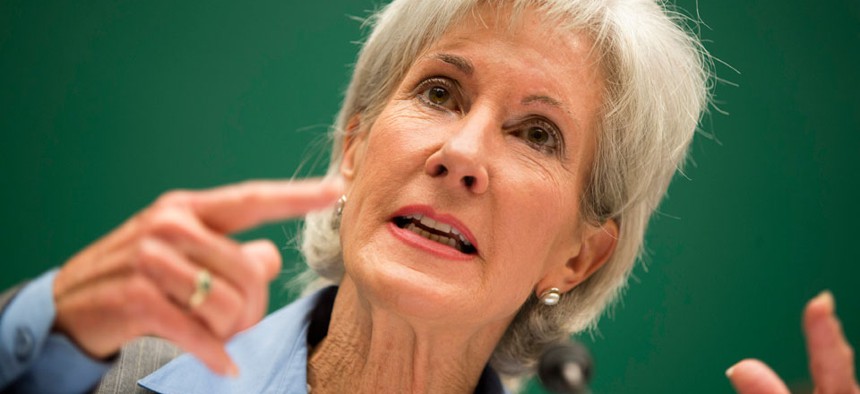Sebelius: HealthCare.gov Restriction Aimed to Avoid Glitches, Not Cause Them

Evan Vucci/AP
A last-minute change forcing ‘window shoppers’ to register contributed to the site’s disastrous launch, vendor says.
A late decision to force visitors to register with the government’s online health insurance marketplace before they could see insurance plan prices was aimed at avoiding glitches, Health and Human Services Secretary Kathleen Sebelius told lawmakers on Wednesday.
She linked that decision with several other services the government opted to “pare back” during the last weeks before HealthCare.gov’s Oct. 1 launch in an effort to not bog the site down with extra tools.
As things turned out, that decision probably contributed to the site’s terrible performance during its first weeks online, according to earlier testimony from Quality Software Services, or QSSI, the contractor that built the faulty registration system and is now leading a “tech surge” to bring HealthCare.gov into working order by Nov. 30.
That late change forced more people into the registration system than it could handle, exacerbating other glitches, QSSI’s Group Executive Vice President Andrew Slavitt said.
As a result of that glitch and others, less than 1 percent of insurance seekers completed enrollment in a plan through HealthCare.gov during its first weeks online. The site’s performance has improved since then, but a majority of insurance seekers still don’t appear to be completing enrollment. The White House has declined to release enrollment numbers, saying they’d be inaccurate and misleading at this point.
Republican lawmakers have charged the decision to disable anonymous shopping was a political dictate from the White House aimed at preventing Americans who didn’t want to purchase insurance through the new marketplaces from learning those plans’ true costs.
Sebelius denied that charge under questioning from the House Energy and Commerce Committee Wednesday.
She said the decision didn’t come from her or from the White House but from Centers for Medicare and Medicaid Services Director Marilyn Tavenner. CMS was the lead agency managing the building and launch of HealthCare.gov.
Sebelius began Wednesday’s testimony by acknowledging that “early access to HealthCare.gov has been a miserably frustrating experience for too many Americans.”
She also renewed a pledge made by Tavenner and White House officials that the site would be fully operational by Nov. 30th but noted it’s unlikely to be running at full capacity any sooner than that.
Sebelius acknowledged that the two weeks of end-to-end testing HealthCare.gov underwent were clearly inadequate, but disputed a claim by some Republican lawmakers that lead contractors on the project warned CMS that the lack of testing could prove disastrous.
Those claims were largely based on a Sept. 6 progress report from CGI Federal, the main vendor for the marketplace’s backend, which was provided to the House Oversight Committee and posted online late Tuesday.
The report noted that the period allotted for performance testing and other forms of testing was inadequate. Sebelius described that as contractors saying what they wanted, not what they needed.
“The contractors said we would have loved more testing time but ultimately we’re ready to go,” she said, adding “no one ever imagined the volume of issues and problems we’ve had and that we need to fix.”
CGI and QSSI testified last week that they did not recommend delaying the launch because they were only responsible for verifying that their own portions of the system were ready to run, not the end-to-end system, which was CMS’s responsibility.
Much of Wednesday’s hearing steered clear of HealthCare.gov’s technical problems and focused on a partisan dispute about whether the president’s health care reform plan had caused private insurers to cancel some plans.



